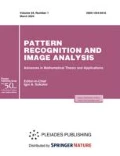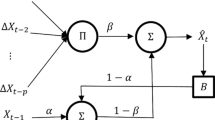Abstract
Applicability of neural nets in time series forecasting has been considered and researched. For this, training of fully connected and recurrent neural networks on various time series with preliminary selection of optimal hyperparameters (optimization algorithm, amount of neurons on hidden layers, amount of epochs during training) has been performed. Comparative analysis of received neural networking forecasting models with each other and regression models has been performed. Conditions, affecting on accuracy and stability of results of the neural networks, have been revealed.






Similar content being viewed by others
REFERENCES
I. A. Chuchueva, “The time series forecasting model by maximum likelihood sampling,” Candidate of Science Dissertation (Bauman Moscow State Technical University, Moscow, 2012) [in Russian].
K. Hornik, M. Stinchcombe, and H. White, “Multilayer feedforward networks are universal approximators,” Neural Networks 2 (5), 359–366 (1989).
Y. Bengio and Y. LeCun, “Scaling learning algorithms towards AI,” in Large-Scale Kernel Machines, Ed. by L. Bottou, O. Chapelle, D. DeCoste, and J. Weston (MIT Press, Cambridge, MA, 2007), pp. 323–362.
S. Hochreiter and J. Schmidhuber, “Long-Short Term Memory,” Neural Comput. 9 (8), 1735–1780 (1997).
R Development Core Team, R: A language and environment for statistical computing. R Foundation for Statistical Computing (Vienna, Austria, 2018). Available at https://www.R-project.org/.
J. J. Allaire and F. Chollet, Keras: R Interface to 'Keras'. R package version 2.2.0 (2018). https://CRAN.R-project.org/package=keras.
J. Duchi, E. Hazan, and Y. Singer, “Adaptive subgradient methods for online learning and stochastic optimization,” J. Mach. Learn. Res. 12, 2121–2159 (2011).
S. Ruder, “An overview of gradient descent optimization algorithms,” arXiv preprint arXiv:1609.04747v2 (2017). https://arxiv.org/abs/1609.04747. Accessed January 19, 2019.
Author information
Authors and Affiliations
Corresponding author
Ethics declarations
The authors declare that they have no conflicts of interest.
Additional information

Stanislav Sholtanyuk. Born in 1996. Assistant of the Department of Computer Applications and Systems, Faculty of Applied Mathematics and Computer Science, Belarusian State University.
Rights and permissions
About this article
Cite this article
Sholtanyuk, S. Comparative Analysis of Neural Networking and Regression Models for Time Series Forecasting. Pattern Recognit. Image Anal. 30, 34–42 (2020). https://doi.org/10.1134/S1054661820010137
Received:
Revised:
Accepted:
Published:
Issue Date:
DOI: https://doi.org/10.1134/S1054661820010137




